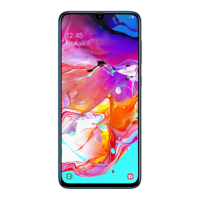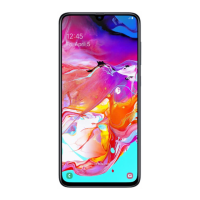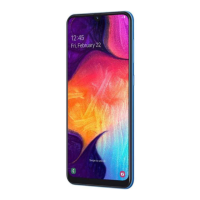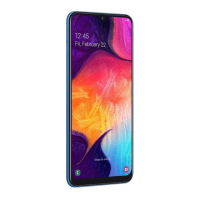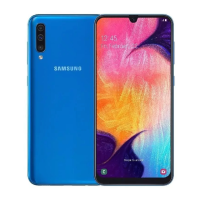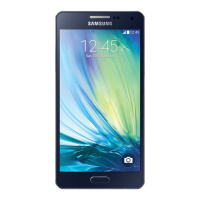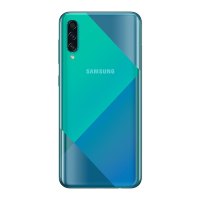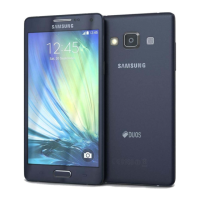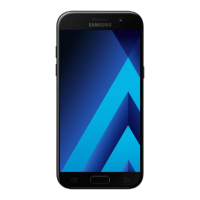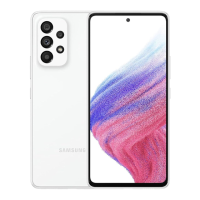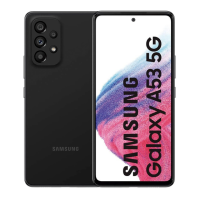Do you have a question about the Samsung SM-A505G and is the answer not in the manual?
Important information before using the device for safe and proper use.
Explanation of warning, caution, and notice icons used in the manual.
Advice on stopping use if the device overheats and warning messages.
Guidance on environmental factors that can cause device heating.
Details about items included in the device package and accessories.
Illustrates and labels the components of the Galaxy A50 model.
Illustrates and labels the components of the Galaxy A70 model.
Explains the function of physical buttons like Volume and Side keys.
Describes the navigation bar buttons (Recents, Home, Back).
Information on charging the device battery.
Tips and options to conserve battery power on the device.
Advice and warnings related to charging the device battery.
Details about the device's built-in fast charging feature.
Instructions for installing and managing SIM or USIM cards.
Steps for activating and customizing dual SIM cards.
Information on installing and using microSD cards.
Steps to safely unmount and remove the memory card.
Instructions on how to format a memory card on the device.
Procedures for powering the device on, off, and restarting.
How to force restart the device if it freezes.
Activating and deactivating emergency mode for reduced battery consumption.
Step-by-step guide for setting up the device after first use or reset.
Information about Samsung accounts and how to create one.
Steps to sign in to an existing Samsung account.
How to recover Samsung account ID or reset password.
Steps to remove a Samsung account from the device.
Guide to using Smart Switch for data transfer.
How to back up and restore data using external storage.
Steps for transferring data between device and computer using Smart Switch.
Information on how the device screen works.
Precautions and tips for using the touchscreen properly.
Describes the navigation bar buttons (Recents, Home, Back).
How to hide the navigation bar and use gestures instead.
Overview of the device's Home and Apps screens.
How to navigate between the Home and Apps screens.
How to move icons, shortcuts, and widgets on the Home screen.
Steps to create folders for apps on the Home screen.
Customizing the Home screen layout, wallpaper, themes, and widgets.
Explains common icons found in the status bar.
How the device locks and unlocks the screen.
Options for setting screen lock types like pattern, PIN, password, and biometrics.
Methods for capturing screenshots and available toolbar options.
How to access and use the notification panel and its functions.
How to use and customize quick setting buttons.
Information about the keyboard layout and text entry.
How to change keyboard type and layout.
Features like prediction, emoticons, GIFs, and voice typing.
Steps for copying and pasting text on the device.
Guide to downloading apps from Galaxy Store and Play Store.
How to disable, enable, and manage app permissions.
How to search for content on the device quickly.
Introduction to Bixby, the voice assistant, and its initial setup.
How to interact with Bixby using voice commands.
Introduction to Bixby Vision for image recognition features.
Methods to start and use Bixby Vision.
How Bixby Vision translates or extracts text from images.
Using Bixby Vision to find similar images and related info.
Using Bixby Vision to scan and read QR codes.
Introduction to Bixby Vision for Galaxy A70.
Using Bixby Vision to search for nearby places.
Introduction to Bixby Routines for automating settings.
Steps to add recommended or custom routines.
How to run, view, stop, and manage routines.
Steps for dialing numbers and initiating calls.
How to make calls from call history or contacts.
How to answer or reject incoming calls.
Steps to block unwanted callers and unknown numbers.
Introduction to creating and managing contacts.
Steps for creating a new contact entry.
Introduction to sending and viewing messages.
Steps for composing and sending text or voice messages.
Steps to block messages from specific numbers.
Introduction to browsing the internet and bookmarking pages.
How to enter web addresses, search, and navigate web pages.
Introduction to setting up and using the email application.
Steps to add and configure email accounts.
Introduction to taking photos and recording videos.
Steps and options for capturing photos with the camera.
How to record videos with the camera.
How to choose between ultra-wide and wide-angle lenses.
How to change camera shooting modes like Photo and Scene Optimizer.
Steps to take self-portraits using the front camera.
Using Live Focus to create photos with blurred backgrounds.
How to record videos in super slow motion.
Manually adjusting camera settings like exposure and ISO.
Introduction to viewing and managing images and videos.
How to select and view images, with options for editing and sharing.
How to select and play video files.
How to sync media with Samsung Cloud.
Introduction to creating and using My Emojis, character Emojis, and stickers.
Step-by-step guide to creating personalized My Emojis.
Recording videos with virtual drawings on faces or spaces.
Introduction to viewing information on the screen when it's off.
Configuring display modes and schedules for Always On Display.
Introduction to running multiple apps simultaneously in split or pop-up view.
How to use and adjust the split screen view for two apps.
How to use and manage apps in a pop-up window.
Introduction to managing wellness and fitness goals.
How the device tracks steps and distance, and manages notifications.
Using the app to manage wearable devices.
Support services, diagnostics, and community features.
Creating and deleting notes with text, handwriting, or voice.
Introduction to managing schedules and events.
Steps to create calendar events with details like title, location, and alarms.
How to create tasks as reminders with time or location settings.
Introduction to listening to FM radio.
Steps to scan, select, and listen to FM radio stations.
Introduction to recording and playing voice memos.
Steps for recording, pausing, bookmarking, and finishing voice memos.
Introduction to alarms, world clock, stopwatch, and timer functions.
Setting, stopping, and deleting alarms.
Performing calculations and using unit conversion.
Introduction to gathering and launching games.
Introduction to enhancing the gaming environment with Game Booster.
How to open and configure Game Booster settings.
Introduction to restricting access and setting up a safe environment for children.
How to activate and set up Kids Home for children.
Configuring Kids Home settings and viewing usage history.
Introduction to controlling smart appliances and IoT products.
Connecting Bluetooth headsets and wearable devices.
Registering and controlling smart home devices.
Managing network connections like Wi-Fi and Bluetooth.
Changing settings for Wi-Fi, Bluetooth, NFC, and Airplane mode.
Configuring mobile network settings and data usage.
Activating and connecting to Wi-Fi networks.
Connecting devices directly via Wi-Fi without an access point.
Exchanging data with Bluetooth-enabled devices.
Steps to pair the device with other Bluetooth devices.
Reading NFC tags and using NFC for payments or tickets.
Reducing data usage by preventing background app data activity.
Setting apps to use only mobile data, even on Wi-Fi.
Managing SIM cards for calls, messages, and data.
Sharing the device's mobile data connection with other devices.
Steps to activate and configure the mobile hotspot.
Changing sound modes, ringtones, and notification sounds.
Enabling and selecting modes for Dolby Atmos surround sound.
Playing media sound from specific apps on other audio devices.
Changing notification settings, snooze, badges, and status bar.
Overview of display and Home screen settings.
Adjusting brightness, dark mode, screen mode, font, and touch sensitivity.
Reducing eye strain by applying a blue light filter.
Applying a dark theme to reduce eye strain and save battery.
Adjusting screen mode (Vivid, Natural) and color balance.
Adjusting color tones for personalized display.
Manually adjusting Red, Green, or Blue color values.
Setting up images as a screen saver when the device is charging.
Changing the wallpaper for Home and locked screens.
Applying themes to change the visual elements of the device interface.
Overview of lock screen settings and options.
Setting the device to unlock automatically based on trusted locations or devices.
Options for securing the device using biometrics and other features.
Setting up and using face recognition for unlocking the device.
Warnings and considerations for using face recognition security.
Step-by-step instructions for registering your face for unlock.
Using face unlock and related settings like Stay on Lock screen.
Information on registering and using fingerprint recognition for security.
Step-by-step instructions for registering fingerprints on the sensor.
Using fingerprint unlock and related settings.
Registering biometric data for identity verification and autofill.
Signing into websites using Samsung Pass for autofill.
Using Samsung Pass for automatic address or payment card entry.
Protecting private content and apps with a secure storage area.
Steps to set up Secure Folder with account login and lock methods.
Configuring automatic locking for Secure Folder when not in use.
Steps to move photos, videos, and files into Secure Folder.
Adding apps to use within Secure Folder.
Backing up and restoring Secure Folder content to Samsung Cloud.
Managing privacy settings like permission manager and diagnostic data.
Configuring location information permissions and services.
Syncing, backing up, and restoring data using Samsung Cloud and Smart Switch.
Managing content stored in Samsung Cloud for sync and backup.
Syncing device data (images, videos, events) with Samsung Cloud.
Configuring settings for Google-provided features.
Overview of advanced device features and their settings.
Accessing device data on a computer using Windows 10.
Activating motion features like Lift to wake and double tap to wake.
Installing and using a second instance of messenger apps.
Managing device usage and setting parental controls.
Viewing daily usage history and setting app timers.
Limiting daily usage time for specific applications.
Activating focus mode to avoid distractions and stay focused.
Overview of device status (battery, storage, memory) and optimization.
Quick optimization to improve device performance.
Checking battery status and activating power saving features.
Selecting power modes (Optimized, Medium, Maximum saving).
Checking the status of used and available memory.
Deleting files and uninstalling unused apps.
Checking the device's security status and scanning for malware.
Reducing mobile data usage and compressing internet data.
Customizing system settings and resetting the device.
Selecting device languages and changing keyboard settings.
Resetting device settings or performing a factory data reset.
Improving device accessibility with screen reader and visibility enhancements.
Updating device software via FOTA service.
Accessing device information like status, legal, software, and battery.
Solutions for common device issues like entering codes and error messages.
Solutions for touchscreen malfunctions and performance issues.
Troubleshooting steps for device freezing or errors.
Troubleshooting steps for call connection problems.
Troubleshooting network and audio quality problems.
Solutions for battery charging issues.
Solutions for camera app launch errors.
Solutions for Bluetooth connection and performance issues.
Troubleshooting connection issues between device and computer.
Solutions for GPS and location finding problems.
Importance of backups and responsibility for data loss.
Explains minor physical gaps as manufacturing features.
How to free up storage space by deleting data.
How to view the navigation bar if it disappears.
Important information before using the device for safe and proper use.
Explanation of warning, caution, and notice icons used in the manual.
Advice on stopping use if the device overheats and warning messages.
Guidance on environmental factors that can cause device heating.
Details about items included in the device package and accessories.
Illustrates and labels the components of the Galaxy A50 model.
Illustrates and labels the components of the Galaxy A70 model.
Explains the function of physical buttons like Volume and Side keys.
Describes the navigation bar buttons (Recents, Home, Back).
Information on charging the device battery.
Tips and options to conserve battery power on the device.
Advice and warnings related to charging the device battery.
Details about the device's built-in fast charging feature.
Instructions for installing and managing SIM or USIM cards.
Steps for activating and customizing dual SIM cards.
Information on installing and using microSD cards.
Steps to safely unmount and remove the memory card.
Instructions on how to format a memory card on the device.
Procedures for powering the device on, off, and restarting.
How to force restart the device if it freezes.
Activating and deactivating emergency mode for reduced battery consumption.
Step-by-step guide for setting up the device after first use or reset.
Information about Samsung accounts and how to create one.
Steps to sign in to an existing Samsung account.
How to recover Samsung account ID or reset password.
Steps to remove a Samsung account from the device.
Guide to using Smart Switch for data transfer.
How to back up and restore data using external storage.
Steps for transferring data between device and computer using Smart Switch.
Information on how the device screen works.
Precautions and tips for using the touchscreen properly.
Describes the navigation bar buttons (Recents, Home, Back).
How to hide the navigation bar and use gestures instead.
Overview of the device's Home and Apps screens.
How to navigate between the Home and Apps screens.
How to move icons, shortcuts, and widgets on the Home screen.
Steps to create folders for apps on the Home screen.
Customizing the Home screen layout, wallpaper, themes, and widgets.
Explains common icons found in the status bar.
How the device locks and unlocks the screen.
Options for setting screen lock types like pattern, PIN, password, and biometrics.
Methods for capturing screenshots and available toolbar options.
How to access and use the notification panel and its functions.
How to use and customize quick setting buttons.
Information about the keyboard layout and text entry.
How to change keyboard type and layout.
Features like prediction, emoticons, GIFs, and voice typing.
Steps for copying and pasting text on the device.
Guide to downloading apps from Galaxy Store and Play Store.
How to disable, enable, and manage app permissions.
How to search for content on the device quickly.
Introduction to Bixby, the voice assistant, and its initial setup.
How to interact with Bixby using voice commands.
Introduction to Bixby Vision for image recognition features.
Methods to start and use Bixby Vision.
How Bixby Vision translates or extracts text from images.
Using Bixby Vision to find similar images and related info.
Using Bixby Vision to scan and read QR codes.
Introduction to Bixby Vision for Galaxy A70.
Using Bixby Vision to search for nearby places.
Introduction to Bixby Routines for automating settings.
Steps to add recommended or custom routines.
How to run, view, stop, and manage routines.
Steps for dialing numbers and initiating calls.
How to make calls from call history or contacts.
How to answer or reject incoming calls.
Steps to block unwanted callers and unknown numbers.
Introduction to creating and managing contacts.
Steps for creating a new contact entry.
Introduction to sending and viewing messages.
Steps for composing and sending text or voice messages.
Steps to block messages from specific numbers.
Introduction to browsing the internet and bookmarking pages.
How to enter web addresses, search, and navigate web pages.
Introduction to setting up and using the email application.
Steps to add and configure email accounts.
Introduction to taking photos and recording videos.
Steps and options for capturing photos with the camera.
How to record videos with the camera.
How to choose between ultra-wide and wide-angle lenses.
How to change camera shooting modes like Photo and Scene Optimizer.
Steps to take self-portraits using the front camera.
Using Live Focus to create photos with blurred backgrounds.
How to record videos in super slow motion.
Manually adjusting camera settings like exposure and ISO.
Introduction to viewing and managing images and videos.
How to select and view images, with options for editing and sharing.
How to select and play video files.
How to sync media with Samsung Cloud.
Introduction to creating and using My Emojis, character Emojis, and stickers.
Step-by-step guide to creating personalized My Emojis.
Recording videos with virtual drawings on faces or spaces.
Introduction to viewing information on the screen when it's off.
Configuring display modes and schedules for Always On Display.
Introduction to running multiple apps simultaneously in split or pop-up view.
How to use and adjust the split screen view for two apps.
How to use and manage apps in a pop-up window.
Introduction to managing wellness and fitness goals.
How the device tracks steps and distance, and manages notifications.
Using the app to manage wearable devices.
Support services, diagnostics, and community features.
Creating and deleting notes with text, handwriting, or voice.
Introduction to managing schedules and events.
Steps to create calendar events with details like title, location, and alarms.
How to create tasks as reminders with time or location settings.
Introduction to listening to FM radio.
Steps to scan, select, and listen to FM radio stations.
Introduction to recording and playing voice memos.
Steps for recording, pausing, bookmarking, and finishing voice memos.
Introduction to alarms, world clock, stopwatch, and timer functions.
Setting, stopping, and deleting alarms.
Performing calculations and using unit conversion.
Introduction to gathering and launching games.
Introduction to enhancing the gaming environment with Game Booster.
How to open and configure Game Booster settings.
Introduction to restricting access and setting up a safe environment for children.
How to activate and set up Kids Home for children.
Configuring Kids Home settings and viewing usage history.
Introduction to controlling smart appliances and IoT products.
Connecting Bluetooth headsets and wearable devices.
Registering and controlling smart home devices.
Managing network connections like Wi-Fi and Bluetooth.
Changing settings for Wi-Fi, Bluetooth, NFC, and Airplane mode.
Configuring mobile network settings and data usage.
Activating and connecting to Wi-Fi networks.
Connecting devices directly via Wi-Fi without an access point.
Exchanging data with Bluetooth-enabled devices.
Steps to pair the device with other Bluetooth devices.
Reading NFC tags and using NFC for payments or tickets.
Reducing data usage by preventing background app data activity.
Setting apps to use only mobile data, even on Wi-Fi.
Managing SIM cards for calls, messages, and data.
Sharing the device's mobile data connection with other devices.
Steps to activate and configure the mobile hotspot.
Changing sound modes, ringtones, and notification sounds.
Enabling and selecting modes for Dolby Atmos surround sound.
Playing media sound from specific apps on other audio devices.
Changing notification settings, snooze, badges, and status bar.
Overview of display and Home screen settings.
Adjusting brightness, dark mode, screen mode, font, and touch sensitivity.
Reducing eye strain by applying a blue light filter.
Applying a dark theme to reduce eye strain and save battery.
Adjusting screen mode (Vivid, Natural) and color balance.
Adjusting color tones for personalized display.
Manually adjusting Red, Green, or Blue color values.
Setting up images as a screen saver when the device is charging.
Changing the wallpaper for Home and locked screens.
Applying themes to change the visual elements of the device interface.
Overview of lock screen settings and options.
Setting the device to unlock automatically based on trusted locations or devices.
Options for securing the device using biometrics and other features.
Setting up and using face recognition for unlocking the device.
Warnings and considerations for using face recognition security.
Step-by-step instructions for registering your face for unlock.
Using face unlock and related settings like Stay on Lock screen.
Information on registering and using fingerprint recognition for security.
Step-by-step instructions for registering fingerprints on the sensor.
Using fingerprint unlock and related settings.
Registering biometric data for identity verification and autofill.
Signing into websites using Samsung Pass for autofill.
Using Samsung Pass for automatic address or payment card entry.
Protecting private content and apps with a secure storage area.
Steps to set up Secure Folder with account login and lock methods.
Configuring automatic locking for Secure Folder when not in use.
Steps to move photos, videos, and files into Secure Folder.
Adding apps to use within Secure Folder.
Backing up and restoring Secure Folder content to Samsung Cloud.
Managing privacy settings like permission manager and diagnostic data.
Configuring location information permissions and services.
Syncing, backing up, and restoring data using Samsung Cloud and Smart Switch.
Managing content stored in Samsung Cloud for sync and backup.
Syncing device data (images, videos, events) with Samsung Cloud.
Configuring settings for Google-provided features.
Overview of advanced device features and their settings.
Accessing device data on a computer using Windows 10.
Activating motion features like Lift to wake and double tap to wake.
Installing and using a second instance of messenger apps.
Managing device usage and setting parental controls.
Viewing daily usage history and setting app timers.
Limiting daily usage time for specific applications.
Activating focus mode to avoid distractions and stay focused.
Overview of device status (battery, storage, memory) and optimization.
Quick optimization to improve device performance.
Checking battery status and activating power saving features.
Selecting power modes (Optimized, Medium, Maximum saving).
Checking the status of used and available memory.
Deleting files and uninstalling unused apps.
Checking the device's security status and scanning for malware.
Reducing mobile data usage and compressing internet data.
Customizing system settings and resetting the device.
Selecting device languages and changing keyboard settings.
Resetting device settings or performing a factory data reset.
Improving device accessibility with screen reader and visibility enhancements.
Updating device software via FOTA service.
Accessing device information like status, legal, software, and battery.
Solutions for common device issues like entering codes and error messages.
Solutions for touchscreen malfunctions and performance issues.
Troubleshooting steps for device freezing or errors.
Troubleshooting steps for call connection problems.
Troubleshooting network and audio quality problems.
Solutions for battery charging issues.
Solutions for camera app launch errors.
Solutions for Bluetooth connection and performance issues.
Troubleshooting connection issues between device and computer.
Solutions for GPS and location finding problems.
Importance of backups and responsibility for data loss.
Explains minor physical gaps as manufacturing features.
How to free up storage space by deleting data.
How to view the navigation bar if it disappears.
| Resolution | 1080 x 2340 pixels |
|---|---|
| Processor | Exynos 9610 |
| RAM | 4GB / 6GB |
| Storage | 64GB / 128GB |
| Rear Camera | 25 MP + 8 MP + 5 MP |
| Front Camera | 25 MP |
| Battery | 4000 mAh |
| Dimensions | 158.5 x 74.7 x 7.7 mm |
| Weight | 166 g |
| Colors | Black, White, Blue, Coral |
| Model | Samsung SM-A505G (Galaxy A50) |
| Display | 6.4 inches |
| Operating System | Android 9.0 (Pie) |
